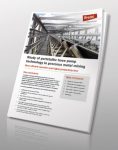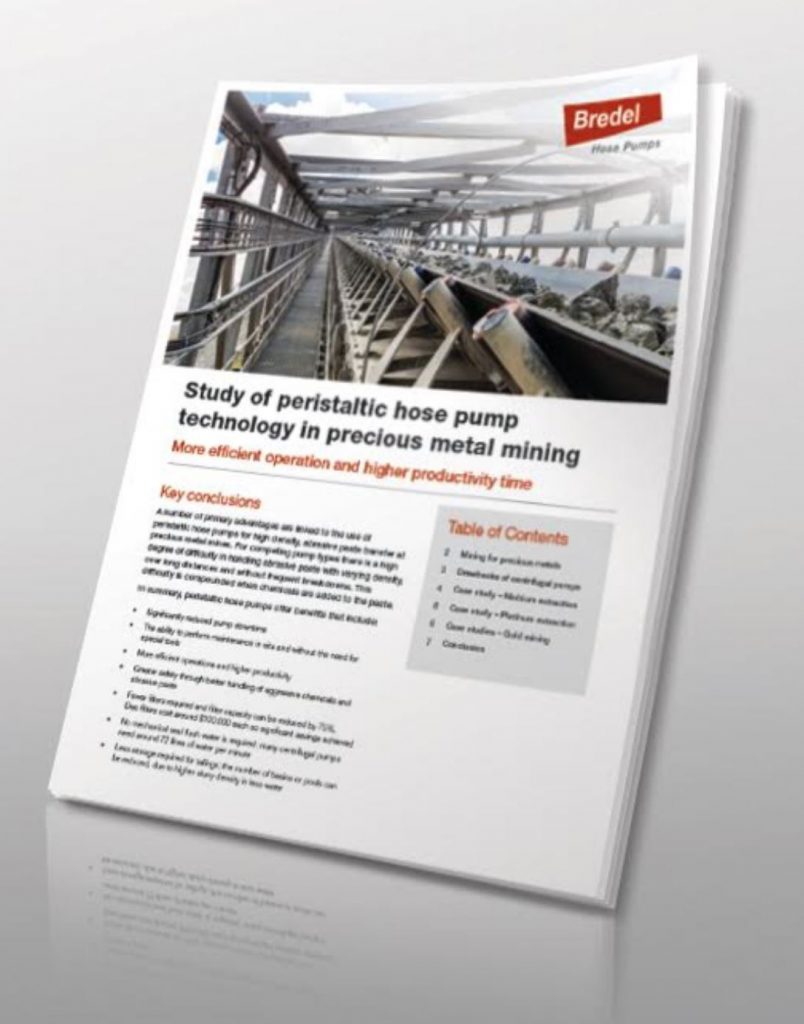UNITED KINGDOM – A new white paper from
Watson-Marlow Fluid Technology Group (WMFTG) concludes that using peristaltic hose pumps enhances precious metals mining. The paper says that in order to maximise profitability through improved uptime, reduced maintenance costs and enhanced site safety, mine operators should leverage the benefits of peristaltic hose pumps.

Mines often use at least two pumps per tank, one to lift from the tank and the other to feed a filter up to 300 metres away.
Wilfried Staijen, account manager for Bredel hose pumps at WMFTG explained the focus of the white paper:
“Traditionally, centrifugal pumps have been adopted widely in precious metal mining, especially for thickener underflow applications, but they have many notable shortcomings. By way of example, the quantity of dry solids that can be accommodated by centrifugal pumps is limited. In numerous applications, pump impellers last just a few weeks due to factors such as strong acidity and/or abrasive content.
“We wanted to show mining companies that hose pump output is far less impacted by fluid dynamics such as paste density, viscosity, suction conditions and discharge pressure and are not affected by the abrasive/aggressive nature of paste and chemicals. We are delighted to have a single document that communicates these points so effectively.”
Peristaltic hose pumps are virtually maintenance free. The only wear part is the hose, which can be replaced
in situ, without any requirement for special tools.
WMFTG’s white paper offers plenty of examples of mines that have benefited from hose pumps. For example, at the CMOC International mine in Ouvidor, Brazil, which is mining and processing niobium, an element found increasingly in the super alloys used to manufacture heat resistant jet engine components. Paste at Ouvidor is made up of 44% niobium with water, sulphuric acid, isopropyl and a flocculent. The solids content rises to 75% as the pulp becomes more concentrated at the bottom of the underflow thickener tank.
Previously, the mine discovered that centrifugal pumps could not manage such a high concentration, and suffered badly due to abrasive wear and chemical attack. Instead, the Ouvidor mine today has several peristaltic hose pumps, some of which have been providing reliable operation for nearly a decade. Bredel 100, 80, 65 and 50 units are all pumping niobium pulp in tank transfer duties, running 18 to 24 hours per day.
The white paper also offers many more examples of benefits of Bredel pumps in precious metal mining applications. A full copy of the paper can be downloaded
here.

 Mines often use at least two pumps per tank, one to lift from the tank and the other to feed a filter up to 300 metres away.
Wilfried Staijen, account manager for Bredel hose pumps at WMFTG explained the focus of the white paper:
“Traditionally, centrifugal pumps have been adopted widely in precious metal mining, especially for thickener underflow applications, but they have many notable shortcomings. By way of example, the quantity of dry solids that can be accommodated by centrifugal pumps is limited. In numerous applications, pump impellers last just a few weeks due to factors such as strong acidity and/or abrasive content.
“We wanted to show mining companies that hose pump output is far less impacted by fluid dynamics such as paste density, viscosity, suction conditions and discharge pressure and are not affected by the abrasive/aggressive nature of paste and chemicals. We are delighted to have a single document that communicates these points so effectively.”
Peristaltic hose pumps are virtually maintenance free. The only wear part is the hose, which can be replaced in situ, without any requirement for special tools.
WMFTG’s white paper offers plenty of examples of mines that have benefited from hose pumps. For example, at the CMOC International mine in Ouvidor, Brazil, which is mining and processing niobium, an element found increasingly in the super alloys used to manufacture heat resistant jet engine components. Paste at Ouvidor is made up of 44% niobium with water, sulphuric acid, isopropyl and a flocculent. The solids content rises to 75% as the pulp becomes more concentrated at the bottom of the underflow thickener tank.
Previously, the mine discovered that centrifugal pumps could not manage such a high concentration, and suffered badly due to abrasive wear and chemical attack. Instead, the Ouvidor mine today has several peristaltic hose pumps, some of which have been providing reliable operation for nearly a decade. Bredel 100, 80, 65 and 50 units are all pumping niobium pulp in tank transfer duties, running 18 to 24 hours per day.
The white paper also offers many more examples of benefits of Bredel pumps in precious metal mining applications. A full copy of the paper can be downloaded
Mines often use at least two pumps per tank, one to lift from the tank and the other to feed a filter up to 300 metres away.
Wilfried Staijen, account manager for Bredel hose pumps at WMFTG explained the focus of the white paper:
“Traditionally, centrifugal pumps have been adopted widely in precious metal mining, especially for thickener underflow applications, but they have many notable shortcomings. By way of example, the quantity of dry solids that can be accommodated by centrifugal pumps is limited. In numerous applications, pump impellers last just a few weeks due to factors such as strong acidity and/or abrasive content.
“We wanted to show mining companies that hose pump output is far less impacted by fluid dynamics such as paste density, viscosity, suction conditions and discharge pressure and are not affected by the abrasive/aggressive nature of paste and chemicals. We are delighted to have a single document that communicates these points so effectively.”
Peristaltic hose pumps are virtually maintenance free. The only wear part is the hose, which can be replaced in situ, without any requirement for special tools.
WMFTG’s white paper offers plenty of examples of mines that have benefited from hose pumps. For example, at the CMOC International mine in Ouvidor, Brazil, which is mining and processing niobium, an element found increasingly in the super alloys used to manufacture heat resistant jet engine components. Paste at Ouvidor is made up of 44% niobium with water, sulphuric acid, isopropyl and a flocculent. The solids content rises to 75% as the pulp becomes more concentrated at the bottom of the underflow thickener tank.
Previously, the mine discovered that centrifugal pumps could not manage such a high concentration, and suffered badly due to abrasive wear and chemical attack. Instead, the Ouvidor mine today has several peristaltic hose pumps, some of which have been providing reliable operation for nearly a decade. Bredel 100, 80, 65 and 50 units are all pumping niobium pulp in tank transfer duties, running 18 to 24 hours per day.
The white paper also offers many more examples of benefits of Bredel pumps in precious metal mining applications. A full copy of the paper can be downloaded
Comments